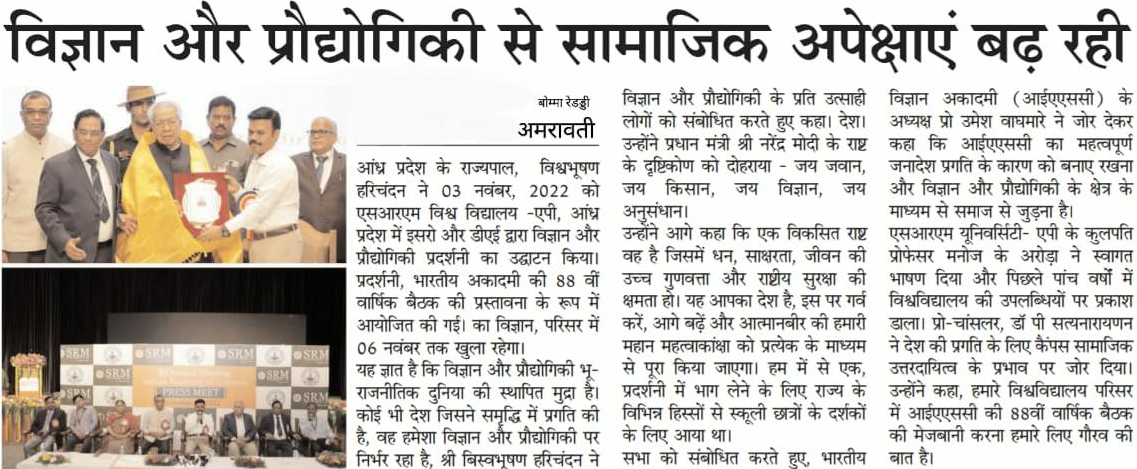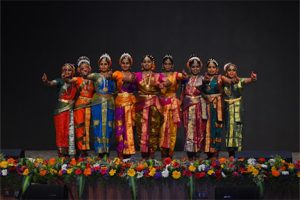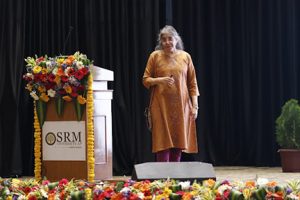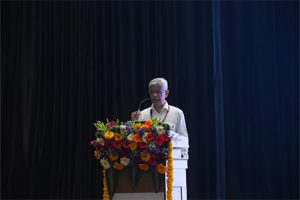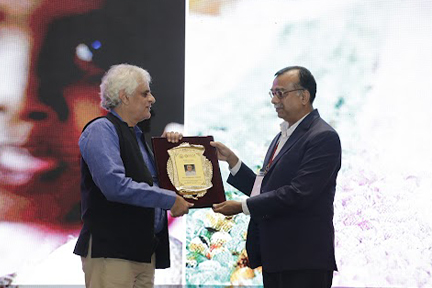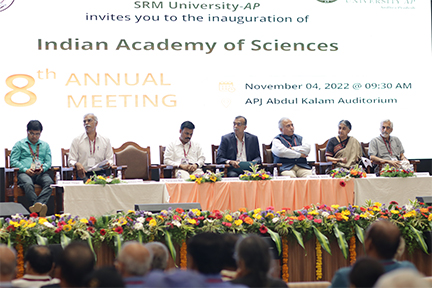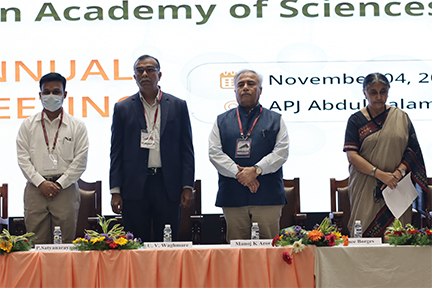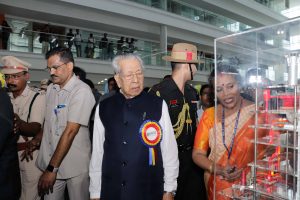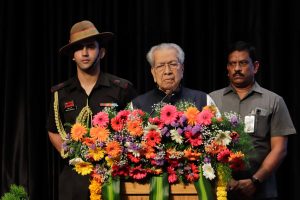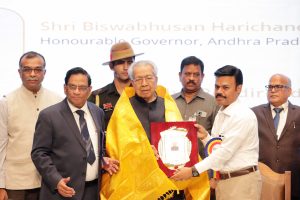- The second day of 88th Annual Meeting of Indian Academy of Sciences at SRM University- AP November 7, 2022

The second day of the 88th Annual Meeting of the Indian Academy of Sciences held at SRM University- AP on Saturday, November 05, 2022, continued to behold the momentum of the first day of the gathering. The highlights of the day were the Lectures by fellows and associates, a Symposium on “Floods in the Anthropocene,” and a public lecture on “The Modern Life of an Ancient Language” by Ananya Vajpeyi, Centre for The Study of Developing Societies, New Delhi.
The first session in the morning, lectures by fellows and associates, was chaired by G V Anand, Dayanand Sagar University, Bengaluru. The series of lectures commenced with a talk on “The Novel (IZ4) spreading code design for NavIC’s LISPS signal” by P Vijay Kumar, IISc, Bengaluru. The lecture focused on the NAVigation with Indian Constellation (NavIC), an indigenous regional navigation satellite system developed by ISRO, and other related topics.
Anil K Tripathi, BHU, Varanasi, did the second lecture on the “Regulatory cascades of alternative sigma factors are involved in controlling rhizocompetence in a plant growth promoting rhizobacterium, Azospirillum brasilense.” The lecture focused on Azospirillum brasilense, one of the most ubiquitous plant growth-promoting rhizobacteria, which can sense and detoxify Reactive Oxygen Species (ROS) released by plants. Furthermore, the talk proceeded to discuss how bacteria respond to changes in their internal and external environment by expressing genes needed to cope with the challenges of the altered environment. The session elaborated on the changes faced in the root zone, the rizhocompitance of plants, the fundamental ways in which the roots respond to changes happening in the roots, the effect of stigma factors, and many more.
Atul Geol, CORI, Lucknow, did his lecture on “Development of donor-acceptor-based fluorescent dyes for diagnostics and biomedical applications.” He detailed the pioneered breakthrough innovations of basic building blocks for synthesising TAQMAN-like probes and alternate conjugation chemistry to develop complete RT-PCR kits for detecting SARS-CoV-2 variants. He also expressed how his team is engaged in developing efficient approaches for synthesising new organic fluorescent dyes with absorption and emission at various wavelengths for biomedical and diagnostics applications.
The Development origins of Health and diseases (DOHaD)) hypothesis suggests that early life exposure, including maternal nutrition and phenotype, can predict the risk of non-communicable diseases (NCDs). The session on “Early life exposure and future risk of non-communicable diseases: Relevance in the Indian context” by GR Chandak, CCMB, Hyderabad, elaborated this hypothesis furthermore. It explained the dissection of gene-gene and gene-environment interaction that can predict the future risk of NCDs.
The lectures by fellows and associates were succeeded by a symposium on “Floods in the Anthropocene.” Introduction to this exciting session was done by the Convener Pradeep P Mujumdar, IISc Bengaluru. He provided an overall idea regarding the title of the symposium. He reflected on the ecological and geographical aspects of the topic. He talked a bit about the repeating patterns of floods, the changing frequency of rains, the effect of reservoir operation on floods, etc.
Rajiv Sinha from IIT, Kanpur, was the first to deliver a lecture in this session and was on the “Hydrogeomorphology and sediment dynamics of floods.” He explained that there are particular settings where floods occur more frequently than in other riverbeds and stated that understanding this can help predict the potential sites of floods. The session discussed relevant topics such as the worldwide distribution of floods, Floods in large rivers, Natural or human-induced reasons for floods, Rivers in the Anthropocene concerning specific reference to flood hazards, geomorphology of rivers, floods, and sediment dynamics, dynamic flood topography and many more. The session also put a thought upon the false sense of security while living close to larger rivers that eventually result in irreversible loss. Moreover, he introduced the idea of integrating river morphology into flood management.
The topic “Extreme precipitation under human-induced climate change” was handled by Subimal Ghosh, IIT, Mumbai. Spatial and temporal resolutions of rainfall, extreme precipitation, thermodynamic and dynamic contributions to changing precipitation, atmospheric instability and precipitation, future changes in different warming levels, impacts of urbanisation, and many other topics were under discussion.
The next session on “Deciphering the role of climate change in floods” by Arpita Mondal, IIT Mumbai, explained how a once-in-a-thousand-year event, flood, became a once-in-10-years event with a detailed analysis of the recent flood emergencies occurred in India. She also stressed the attribution analysis of floods, anthropologic climate change, Spatio-temporal scales to define the event, and many other areas.
The last speaker of the symposium was J Indu, IIT Mumbai, and was centered around the topic “Floods from the vantage point of Radars.” She started the lecture by questioning the inaccuracy of observing precipitation from satellites for examinations. She also inspected the network of weather radars, forecasting using radar-based rainfalls, the time limit of radar data assimilation, etc. The symposium came to an end with an exciting interactive session that raised numerous constructive queries and composed a space for incredible engagement.
The afternoon sessions started with lectures by fellows and associates, and C Pulla Rao from IIT Tirupati served as the chairperson of the series of lectures. “Distinguished varieties in the polydisc and dilation of commuting matrices” by Sourav Pal, IIT Mumbai, set the start of the lectures.
Binod Sreenivasan, IISc Bengaluru, was in charge of the next session on “Understanding Earth’s magnetic reversals.” He conferred about one of the long-standing questions in dynamo theory: whether the preference for the axial dipole is due to a purely hydrodynamic process influenced by planetary rotation or due to a magnetohydrodynamic process influenced by both rotation and the self-generated magnetic field.
The talk “You are what you eat: linking metabolism to physiology & health” by Ullas K Seetharam, TIFR Mumbai, put forward the importance of discovering or understanding diet or metabolism-driven mechanisms that govern psychological homeostasis to tackle the explosive burden of non-communicable diseases.
The session ended with Meena B Mahajan, IMSc Chennai, through her lecture on “What is hard to prove, and why?”. She instructed formal proofs, the design of formal proof systems and demonstrated its limitations.
Continue reading → - 88th Annual Meeting of Indian Academy of Sciences begins at SRM University-AP November 7, 2022

The 88th Annual Meeting of the Indian Academy of Sciences began on Friday, November 04, 2022, at SRM University- AP. The event, which spans three days, features distinguished fellows and associates of IASc and renowned Professors from premier institutions across the country. Prof. Umesh V Waghmare, President of the Indian Academy of Sciences, inaugurated the Annual Meeting with his presidential address on “Instabilities of crystals and their functional properties”.
Prof. Waghmare’s lecture revolved around the usage of fundamental laws of Physics in identifying instabilities in crystals. It also acquainted the audience with how these fundamental concepts hold supreme importance in the development of predictive models that capture interactions between the instabilities and external forces to predict the material-specific functional behaviour of advanced materials. The noteworthy remarks were Illustrated with crystal instabilities of polar phonons, spin-ordering, and strain that drive the functional properties of ferroelectrics, antiferromagnets, and shape memory alloys, respectively.
In his welcome speech, Prof Manoj K Arora, Vice-chancellor of SRM University- AP, requested the fellow and associate members of IASc to encourage and instil their unwavering admiration and inclination for research and development into the faculty of educational institutions. He also expressed his concerns about how science and technology are instructed to students in classrooms; considering the enthusiasm and genuine yearning for innovations; it should evoke among students to retain the potential for constructive explorations in ages to come.
“The things that kept an organisation like ISRO going beyond human imaginations and expectations is the solemn belief in themselves, the teamwork and the right sublime combination of the wisdom of past generations and the innovative outlook of the young generation”, stated Prof D Narayana Rao as he expressed his immense acclamation towards the institutes that constitute to the research and development of the country. He also asserted why discovering basic science matters or should be appreciated as they might get transformed into the theories of tomorrow. He also added that the scientific community is destined to live up to the responsibility and highlighted the need to upgrade intellectual and material prosperity. He also emphasised that educational institutions are the backbone of research and development in a country, and there are eccentric career opportunities for the youth in the coming years.
Pro-Chancellor of SRM University- AP, Dr P Sathyanarayanan, thanked IASc for believing in the university’s calibre to be a host and a part of the initiative. He said that he is expecting around 10000 students to benefit from the event. Furthermore, he elaborated on the potential of industry and academia coming together for the improvement of research and development of the country.
The inauguration was followed by a special lecture on “Uniqueness of plant mitochondria: Relevance to crop improvement and climate change” by A S Raghavendra, University of Hyderabad. Swagata Gupta from IIT Kharagpur chaired the lecture. The session concentrated on the distinct features of plant mitochondria that set them apart from animal mitochondria. The speaker elaborated on how mitochondrial metabolism can help plants to adapt to climate changes in terms of flooding, global warming, and elevated CO2.
Afternoon sessions started with lectures by fellows and associates and were chaired by K Bhanu Sankara Rao, University of Hyderabad. The first lecture by Dr D B Ramachary, University of Hyderabad, on the “Discovery of sustainable organocatalytic reactions: Expansion of substrate/catalysts scope”. Discussed the discovery of in-situ generated novel reactive primary catalytic species. The session also focused on their direct applications in a variety of selective green bond formations to furnish the chiral functionalised molecules, drugs, drug-like molecules, natural products, and pharmaceuticals. The second speaker Aditya Bandyopadhyay from IIT Kharagpur talked about “Electrified fluid interfaces- Waves and pattern formation”. He detailed how Interactions of electric fields at the interface of two fluids can lead to particle agglomeration at interfaces, as applied to DNA motion at the interface of two aqueous solutions.
The second speaker Aditya Bandyopadhyay from IIT Kharagpur talked about “Electrified fluid interfaces- Waves and pattern formation”. He detailed how Interactions of electric fields at the interface of two fluids can lead to particle agglomeration at interfaces, as applied to DNA motion at the interface of two aqueous solutions.
The special lecture was followed by a Symposium on Green energy. Dr Ranjit Thapa, Associate Dean- Sciences, SRM University- AP, introduced the symposium that provided a deep understanding of hydrogen generation, hydrogen fuel cells, and beyond hydrogen. Dr Ashok K Ganguli, IIT, New Delhi, handled the first session of the symposium on “Photoelectrochemical water splitting for green energy”. The key process of converting water into clean and renewable hydrogen fuel by using highly efficient photocatalysis was discussed. Furthermore, the session also underlined the growing interest in suitable semiconductor materials as photocatalysts for efficient photoelectrochemical water-splitting applications. The transformation needed to achieve the goals of the Paris agreement, the necessity of renewable energy, the difference between clean, green, and renewable energy, photocatalysis, and many more interesting areas were covered during the lecture. The next lecture on “Low-carbon biohydrogen: Enabling through biorefinery” was delivered by S Venkata Mohan, IICT Hyderabad, and was followed by another talk on “Electrochemical energy systems: Hydrogen generation and its use in fuel cells” by S Sampath, IISc, Bengaluru. The symposium came to a close with the lecture of Ramendra Sundar Dey, Institute of NanoScience &Technology, Mohali, on “Electrochemical nitrogen reduction reaction for the synthesis of ammonia: A pathway to a green future”.
All the sessions were followed by meaningful discussions and dialogues with distinguished participants. IASc Secretaries Prof Renees Borges, Prof. Vijay Mohanan Pillai, Treasurer Raghunathan V A and many other dignitaries from the Indian Academy of Sciences, Bengaluru and SRM University-AP, Andhra Pradesh, were present at the sessions.
Read more about the public lecture of P Sainath
Continue reading → - Governor Shri Biswabhusan Harichandan inaugurated ISRO & DAE Exhibition in SRM University-AP November 6, 2022
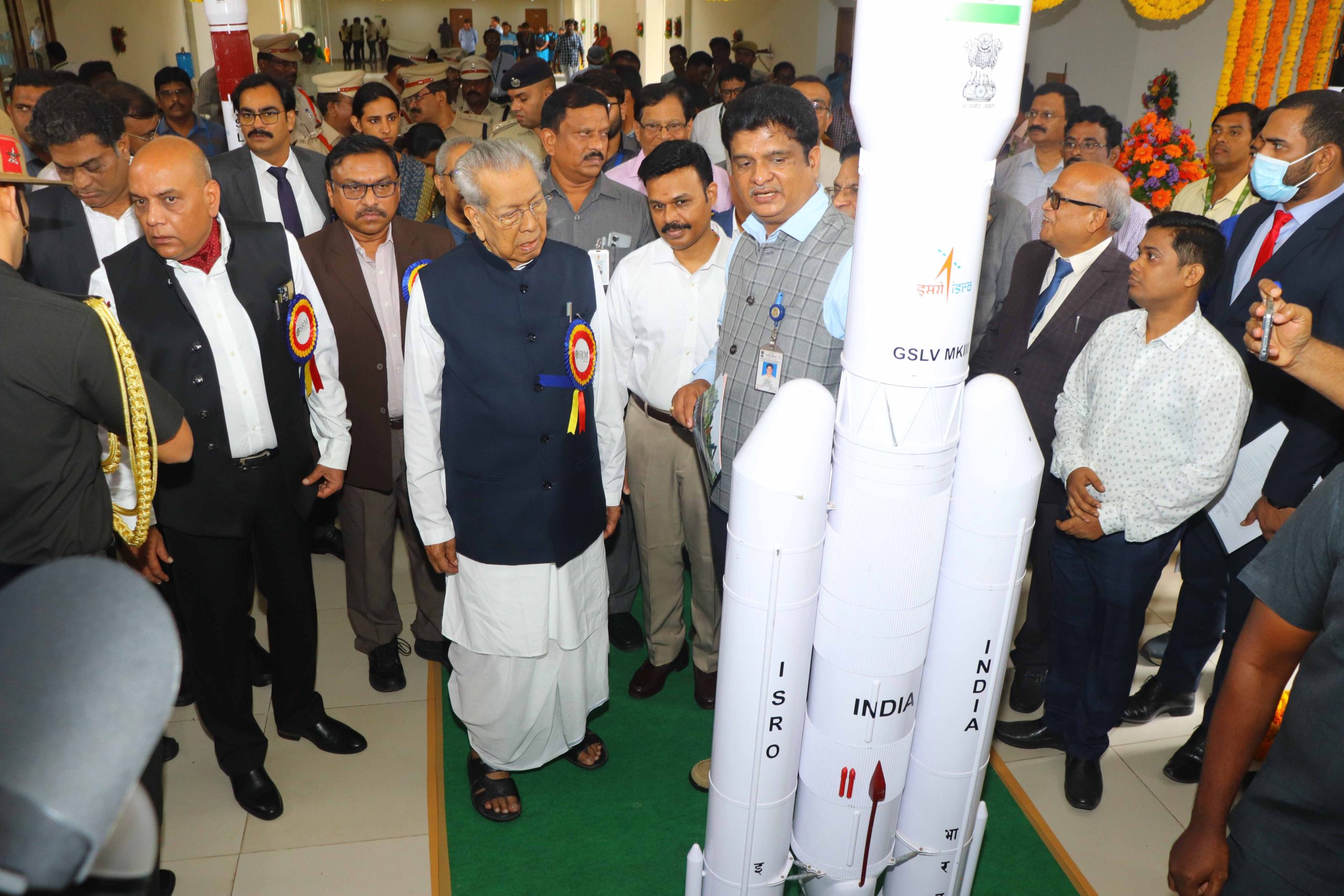 “The societal expectations from science and technology are increasing. Thus, the scientific community has the responsibility to rise to the expectations” said Hon’ble governor to the intellectual gathering.
“The societal expectations from science and technology are increasing. Thus, the scientific community has the responsibility to rise to the expectations” said Hon’ble governor to the intellectual gathering.Governor of Andhra Pradesh, Shri Biswabhusan Harichandan inaugurated the Science and Technology Exhibition, by ISRO and DAE, at SRM University-AP, Andhra Pradesh, on November 03, 2022. The exhibition, organised as a prelude to 88th Annual meeting of the Indian Academy of Sciences, will be open till November 06 on the campus.
“It is known that science and technology are the established currency of the geo-political world. Any country that has made advances in prosperity has invariably depended on science and technology”, remarked Sri Biswabhusan Harichandan addressing the science and technology enthusiasts from all over the country. He reiterated Prime Minister Shri Narendra Modi’s vision of the nation – “Jai Jawan, Jai Kisan, Jai Vigyan, Jai Anusandhan”. He further said that “a developed nation is one that has the capacity for wealth, literacy, high quality of life and national security . This is your country, be proud of it, go ahead and our great ambition of Athmanirbhar will be fulfilled through each one of us”, to the audience of school students came from different parts of the state to attend the exhibition.
Addressing the gathering, Prof Umesh Waghmare, President of the Indian Academy of Sciences (IASc), emphasized that the important mandate of IASc is to uphold the cause of progress and to connect with society through the domain of science and technology. “I am really excited to associate with the students through the exhibitions and meetings organised at SRM AP”, he added.
Prof Manoj K Arora, Vice Chancellor of SRM University- AP, delivered the welcome address and highlighted the achievements of the university in the past five years. Pro-Chancellor, Dr P Sathyanarayanan emphasised the impact of Campus Social Responsibility for the progress of the country. “It is our proud privilege to host the 88th Annual Meeting of IASc at our university campus”, he added. Pro Vice- Chancellor, Prof D Narayana Rao highlighted the achievements of Indians trained in the Athmanirbhar India. He lauded the proactive application of science and technology and the insatiable quest for research and development in the areas of national priority such as world-class communications and remote sensing satellites.
Dr. Pola Bhaskar IAS, Commissioner of Collegiate Education; SRM AP Registrar and many other dignitaries from Indian Academy of Sciences and State and Central government were present on the inaugural function.
Around 1000 students from different schools across the state participated in the first day of Science and Technology Exhibition. The exhibition aims to be an engaging and invigorating platform for students from various regions.There are demonstration models of rocket energy, space research, and nuclear technology, interactive videos on the evolution of technology in ISRO and DAE, and meetup with renowned scientists and technologists. Participants can converse with eminent scientists and researchers on their pathbreaking research works. Apart from the pioneering research models, the exhibition proffers a brief account of various career opportunities at ISRO and DAE. The exhibition will last for the next four days and will be open to the participants free of cost.
In Media: Press Coverage Continue reading → - 88th Annual Meeting of Indian Academy of Sciences begins at SRM University-AP November 5, 2022
The Express
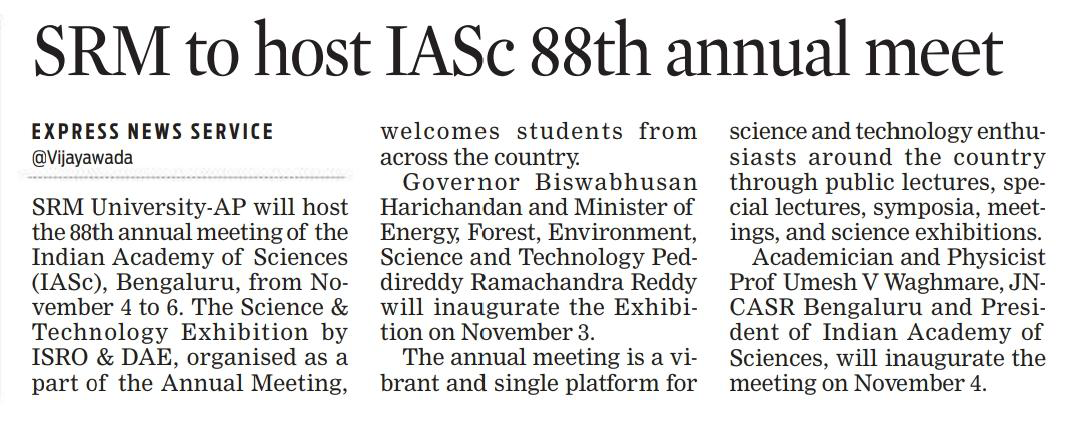
The Hans India

The Hindu

Pioneer

Andhra Patrika

Mangalagiri News
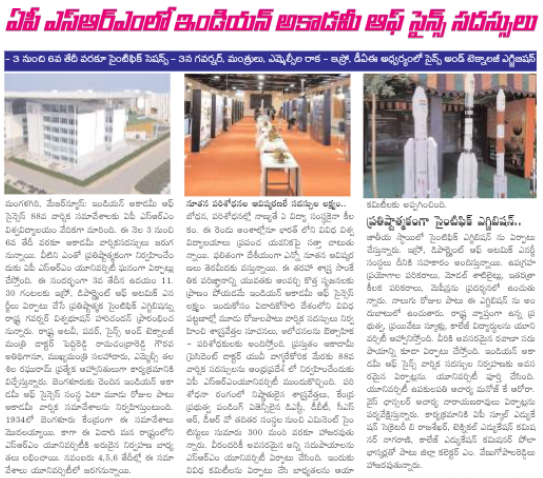
Manam

Prabhata Vartha
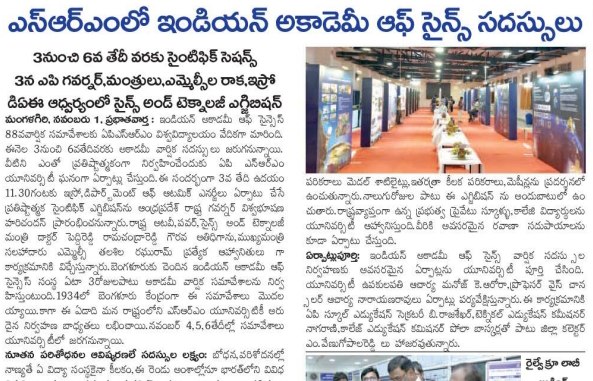
Vartha Prapancham
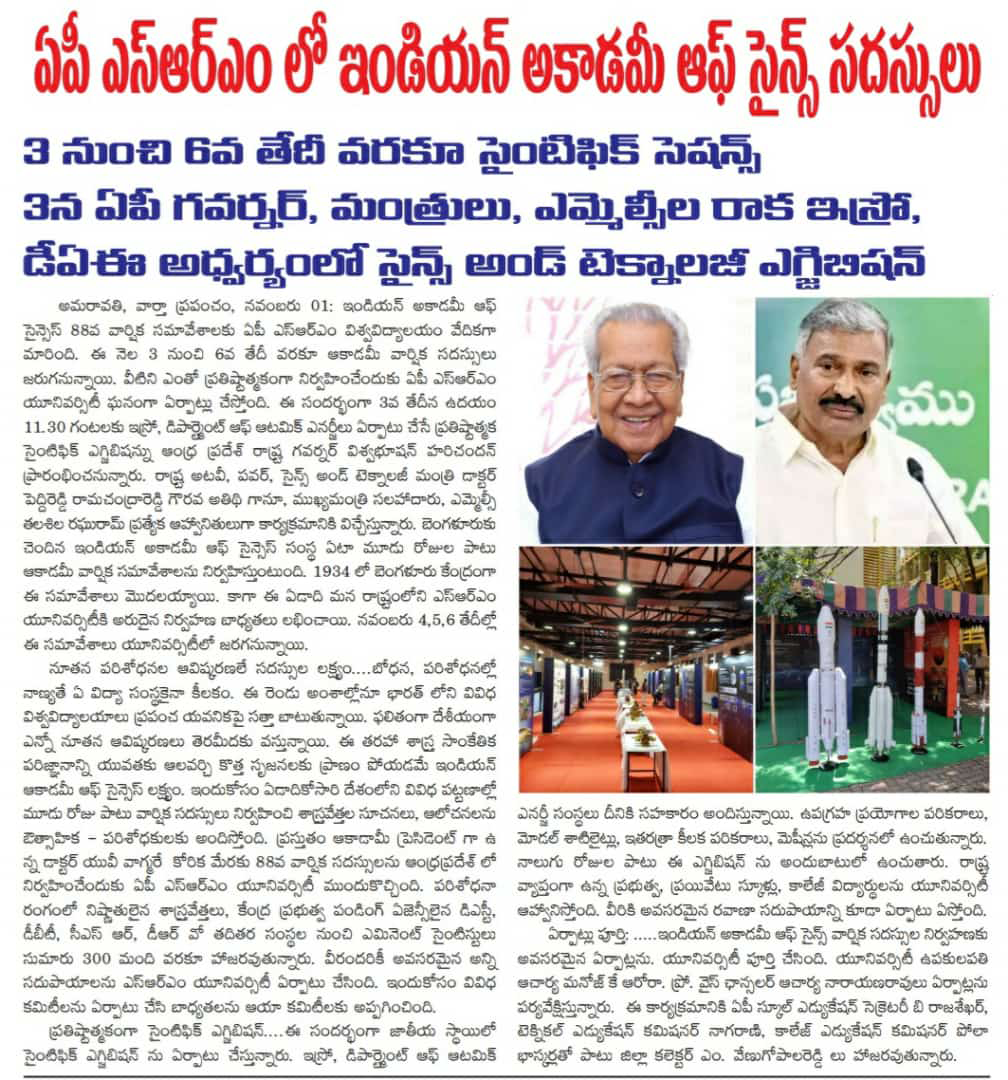
Visalandhra
Continue reading →

- Governor Shri Biswabhusan Harichandan inaugurated ISRO & DAE Exhibition in SRM University-AP November 5, 2022
The Hindu

Deccan Chronicle
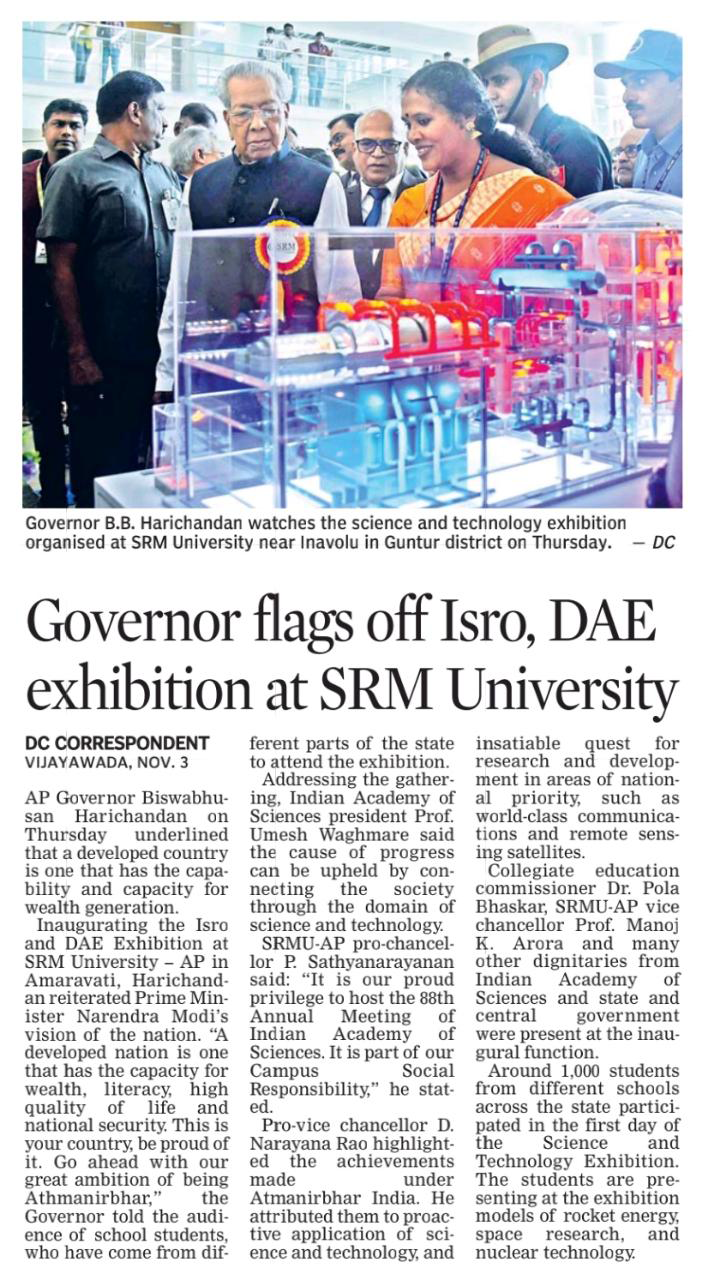
The Express
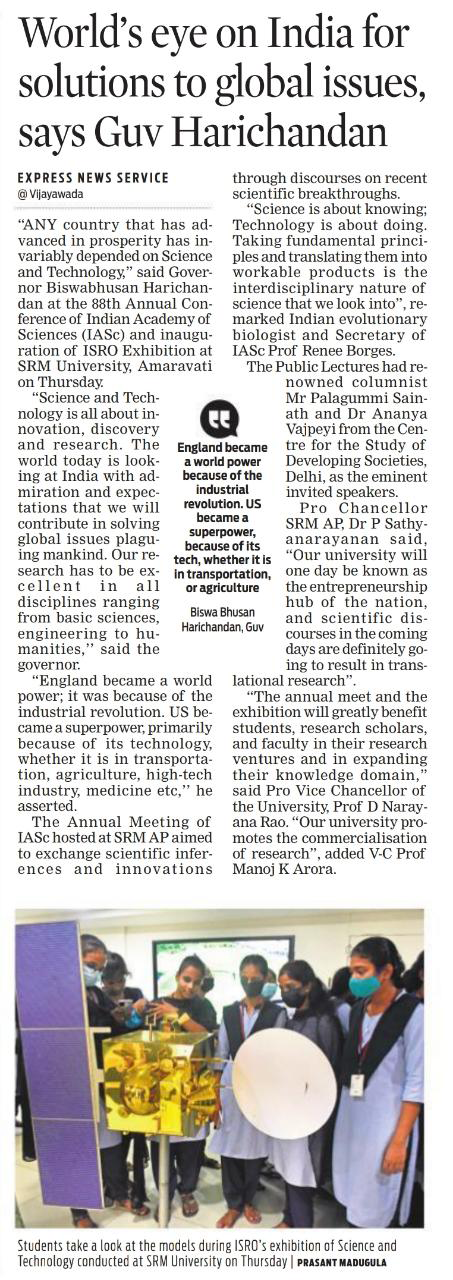
The Hans India

The Pioneer
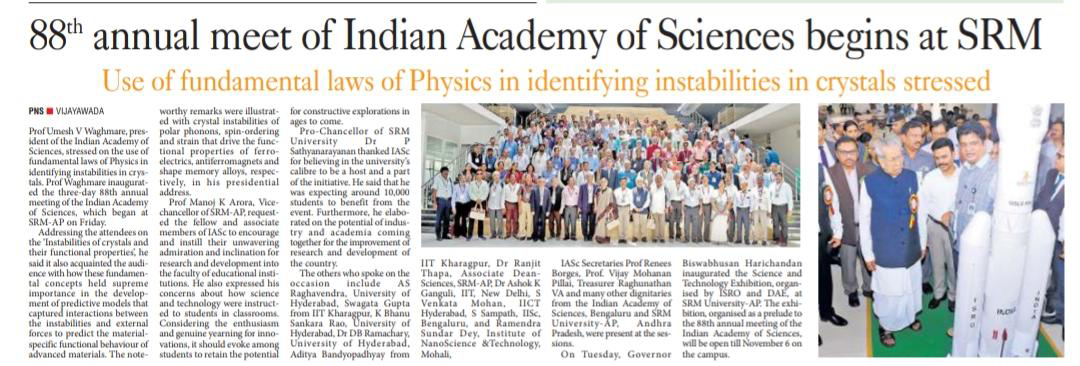
Eenadu
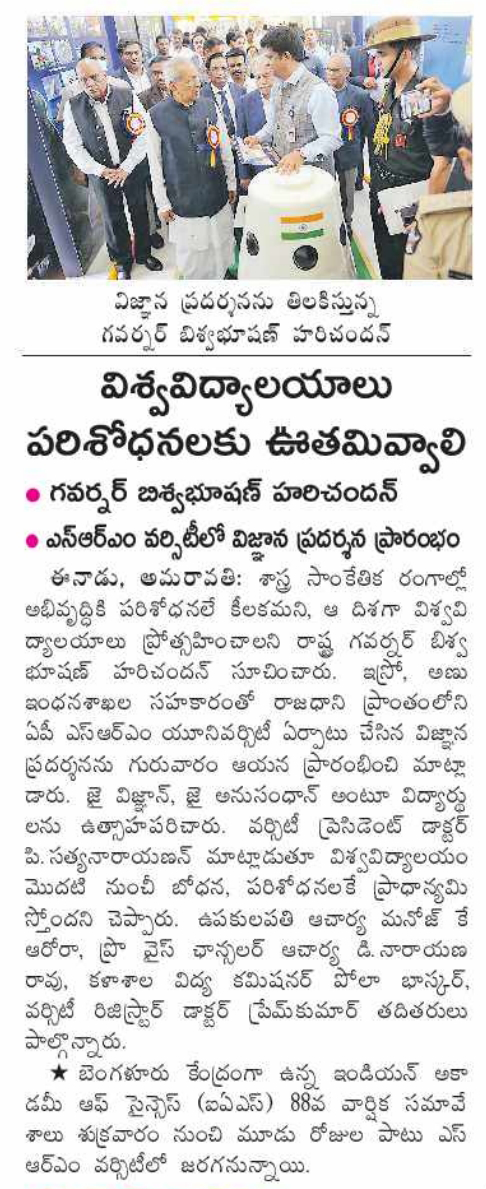
Andhra Patrika

Ankusam

Krishna Jyothi
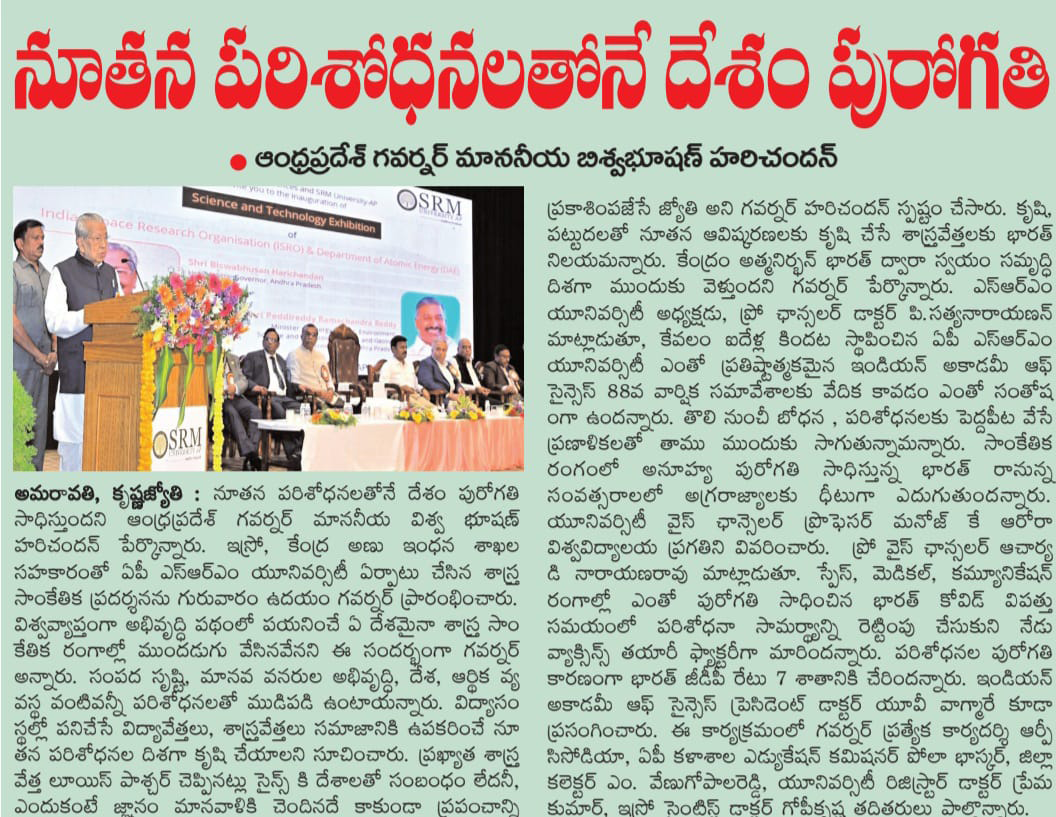
Managalagiri News
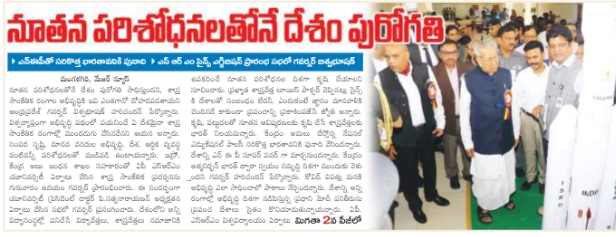
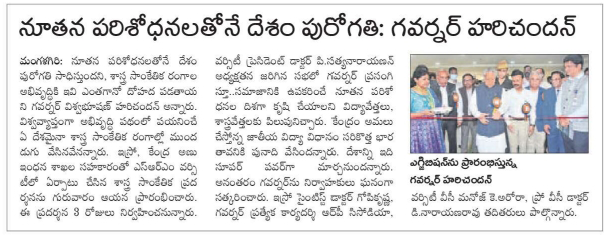
Manam
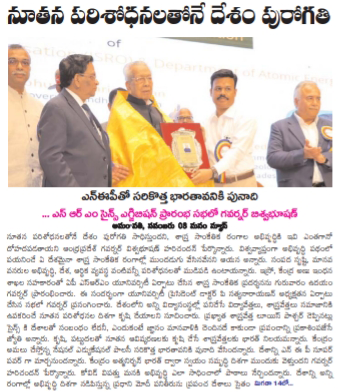

Palanadu Vartha
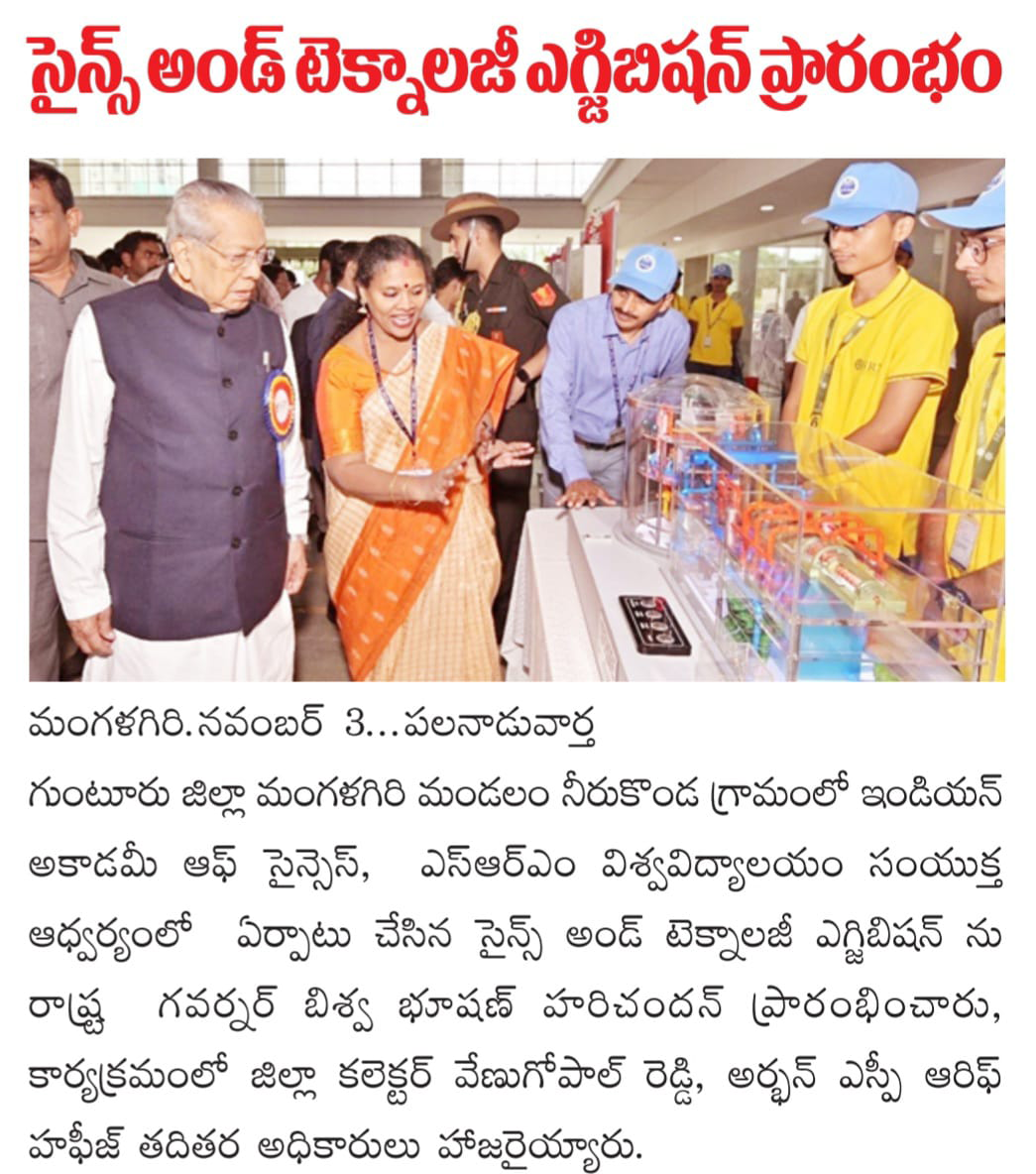
Pratinidhi
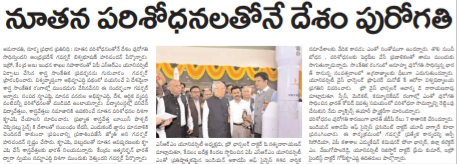
Sattenapalli
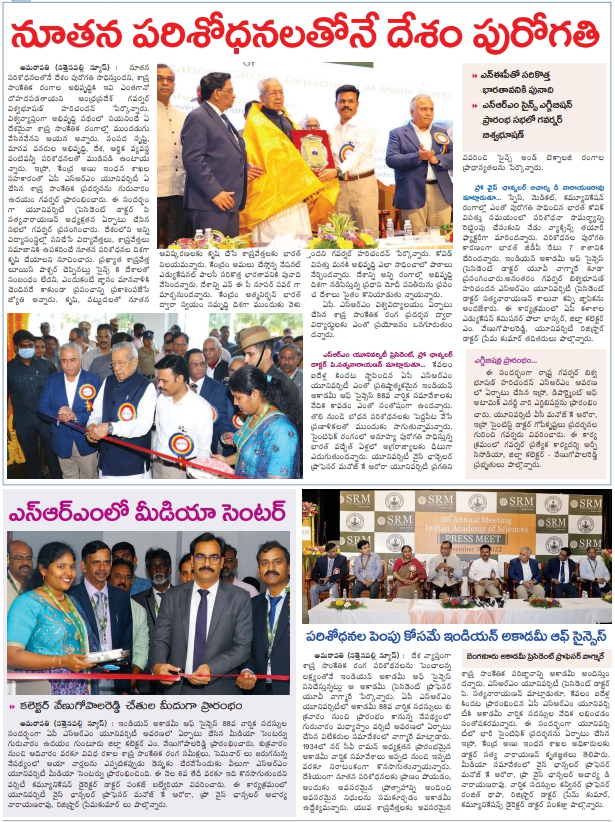
Vartha Prapancham
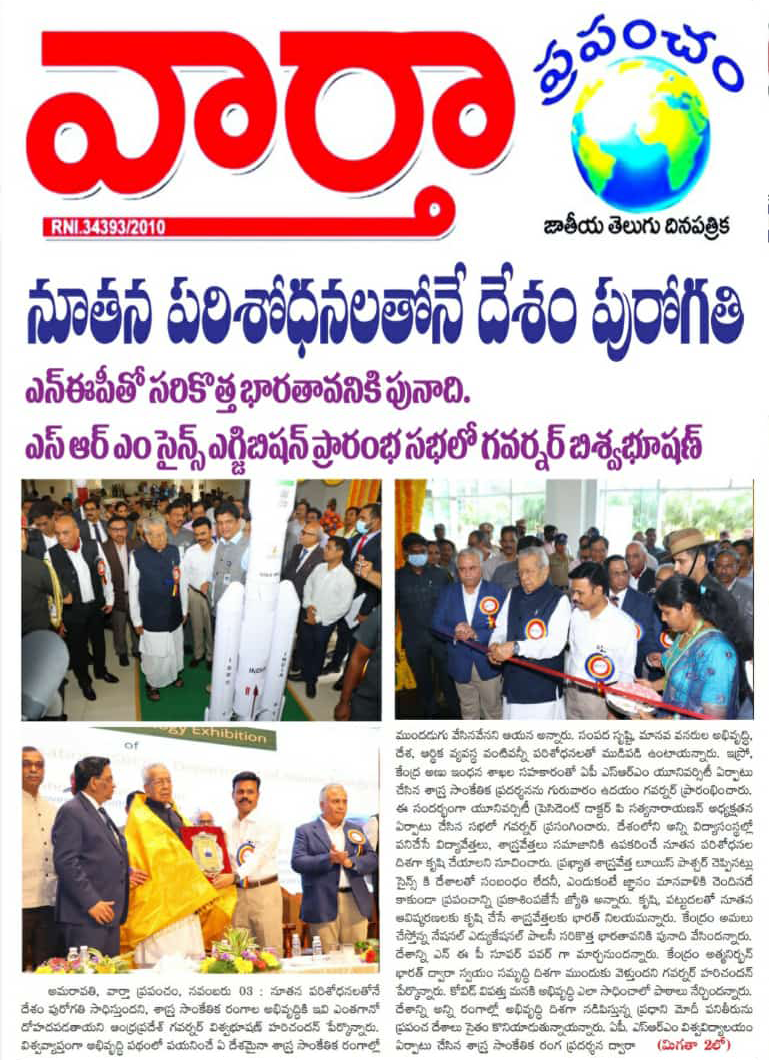
Visalandhra

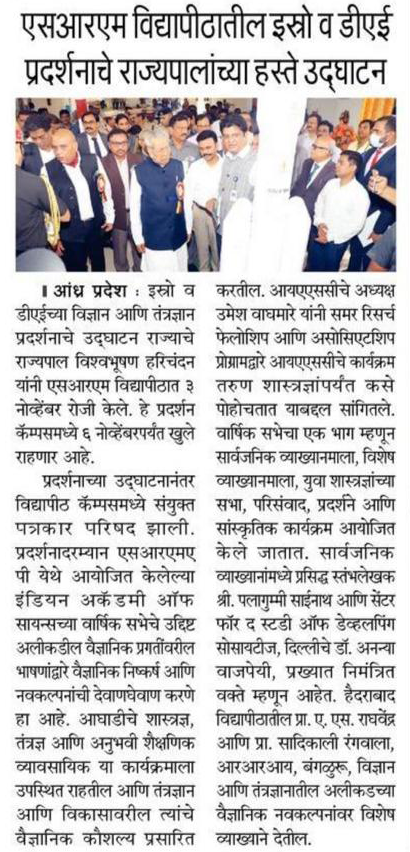
Bommareddy
Continue reading →
